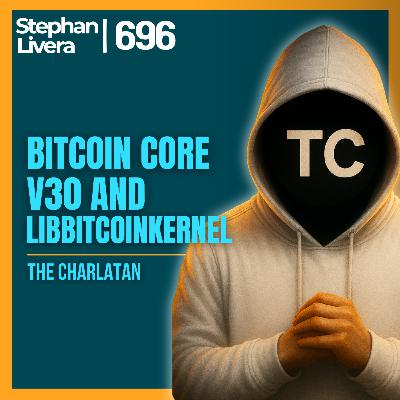Discover Stephan Livera Podcast
Stephan Livera Podcast

Stephan Livera Podcast
Author: Stephan Livera
Subscribed: 1,413Played: 119,210Subscribe
Share
© Stephan Livera
Description
Join Stephan as he interviews the sharpest economic and technical minds in Bitcoin & Austrian Economics to help you understand how money is changing and evolving. Leading names in the world of Bitcoin join the show to share their insights, whether they are developers, CEOs, economists, authors, analysts and more.
708 Episodes
Reverse
In this conversation, I discuss with Nate the current state and future prospects of the Lightning Network as of December 2025. They explore various aspects such as payment success rates, public perception versus practitioner insights, routing fees, centrality in nodes, yield opportunities, privacy considerations, and the overall adoption of the Lightning Network. The discussion highlights the improvements made over the years, the economic incentives for node operators, and the importance of community-driven initiatives in shaping the future of the Lightning Network.=Takeaways:🔸The Lightning Network has improved payment success rates over time.🔸Public perception of the Lightning Network often differs from actual usage statistics.🔸Routing fees are crucial for maintaining liquidity and economic incentives in the network.🔸Centrality in Lightning nodes affects payment success and routing efficiency.🔸Yield opportunities exist for those operating Lightning nodes.🔸Adoption of the Lightning Network is expected to grow as more enterprises recognize its benefits.🔸Privacy in Lightning transactions is nuanced and requires careful management.🔸Innovations in Lightning technology continue to enhance user experience and functionality.🔸The future of the Lightning Network may involve more integration with traditional financial systems.🔸Community-driven initiatives are essential for the growth and improvement of the Lightning Network.Timestamps:00:00 Intro02:53 Current State and Performance of the Lightning Network05:58 Public Perception vs. Practitioner Insights08:53 Routing and Payment Success Rates11:55 Fee Structures and Yield in Lightning Network14:56 The Evolution of Lightning Node Operations17:56 Centralization Concerns in the Lightning Network27:45 Hub and spoke model?30:14 Privacy Concerns in Lightning Network32:41 The Centralization Debate in Lightning Network35:43 Merchant Adoption of Bitcoin Payments38:47 The Role of Bitcoin as a Medium of Exchange40:53 Exploring Lightning Network Implementations45:36 Recommendations for Different User Types50:45 Comparing Lightning Network with Alternative Solutions54:52 Enhancing Bitcoin's Functionality57:37 The Future of Bitcoin Development59:59 Bitcoin Myths and Misconceptions01:02:08 The Importance of Bitcoin Ownership01:06:05 Lightning Network Adoption and Innovations01:11:01 Privacy in the Lightning NetworkLinks:https://x.com/BeefOrBacon1http://billandkeonne.org/https://learn.robosats.org/Sponsor:CoinKite.com (code LIVERA)Stephan Livera links:Follow me on X: @stephanliveraSubscribe to the podcastSubscribe to Substack
In this episode, B10C discusses his work in the Bitcoin ecosystem, focusing on the importance of censorship resistance, the role of mining pools, and the implications of OFAC sanctions on Bitcoin transactions. He introduces the Peer Observer project aimed at monitoring the Bitcoin network for anomalies and attacks, and highlights the need for a collaborative approach to Bitcoin network operations through the Bitcoin Network Operations Collective.Takeaways:🔸B10C has been working on Bitcoin open source projects since 2021.🔸Research on mining pools reveals they may filter out certain transactions.🔸Censorship resistance is a key feature of Bitcoin that needs monitoring.🔸The Bitcoin network lacks a professional monitoring system compared to large companies.🔸The Peer Observer project aims to detect attacks on Bitcoin nodes.🔸Monitoring tools can help identify anomalies in the Bitcoin network.🔸The Bitcoin Network Operations Collective is a forum for collaboration on network monitoring.🔸Compact block relay improves block propagation efficiency.🔸Different mining pools have varying policies on transaction inclusion.🔸The future of Bitcoin monitoring relies on community collaboration.Timestamps:(00:00) - IntroLinks: https://x.com/0xb10c https://b10c.me/ Sponsor:CoinKite.com (code LIVERA)Stephan Livera links:Follow me on X: @stephanliveraSubscribe to the podcastSubscribe to Substack
In this episode the discussion revolves around the BOSS program (Bitcoin Open Source Software), which offers a 30-day series of technical programming exercises aimed at engaging participants in Bitcoin protocol development. The guests, Satsie, Sangbida, and Ron, share their backgrounds, motivations for joining the program, and experiences throughout the challenges. They discuss the impact of the program on their careers, the importance of community support, and the unique environment of open source development. The conversation also touches on the challenges of grant applications and the mindset required to succeed in this field. The episode concludes with advice for potential participants, encouraging them to take the leap and apply for the program.Takeaways:🔸The BOSS program is a free opportunity for learning Bitcoin development.🔸Participants come from diverse backgrounds, including IT and finance.🔸The program is gamified to keep participants motivated.🔸Community support is crucial for success in the program.🔸Contributing to Bitcoin open source is seen as ethical and impactful.🔸The experience in open source differs significantly from corporate environments.🔸Grant applications require a proactive approach and clear proposals.🔸Imposter syndrome is common but can be overcome with dedication.🔸Feedback from the community is direct and valuable for developers.🔸Working in open source can lead to fulfilling and autonomous careers.Timestamps:(00:00) - Intro(01:21) - What is the BOSS program?; Sangbida & Macgyver’s journey with BOSS(04:07) - Participant’s motivation & experiences with the BOSS program(09:00) - What are the career opportunities for Bitcoin developers after the BOSS program? (12:57) - Challenges of learning & working in open source(16:53) - What are Sangbida & Macgyver currently working on?(18:25) - What is it like applying for grants and funding in open source?(19:48) - Sponsor(23:12) - The role of community engagement in open source(25:16) - Skills and mindset required to thrive in open source(30:23) - Working in Bitcoin - passion vs. reality(38:13) - Closing thoughtsLinks: https://x.com/satsie https://bosschallenge.xyz/ https://bitcoindevs.xyz/ https://x.com/Bitcoin_Devs BOSS Challenge: https://x.com/i/status/1996282354969858301 Sponsor:CoinKite.com (code LIVERA)Stephan Livera links:Follow me on X: @stephanliveraSubscribe to the podcastSubscribe to Substack
In this conversation, Davidson, a Bitcoin developer, discusses his project Floresta, which aims to provide a lightweight Bitcoin node solution that balances privacy, security, and usability. He explains the technical aspects of Floresta, including its architecture, the use of compact block filters, and its relationship with Utreexo. Davidson emphasizes the importance of making Bitcoin more accessible to non-technical users while maintaining security and privacy. The discussion also touches on the challenges of running Bitcoin nodes, the potential integration of Floresta with existing applications, and the future of Bitcoin technology.Takeaways:🔸Floresta aims to provide lightweight Bitcoin nodes with better trade-offs.🔸The project is designed for non-technical users who want to run their own nodes.🔸Privacy and security are key concerns in Bitcoin transactions.🔸Floresta uses compact block filters to enhance user experience.🔸The architecture of Floresta allows for easy integration with existing wallets.🔸Proof of work fraud proof offers a new way to validate blocks.🔸Floresta is a library that can be embedded in other applications.🔸User experience is crucial for wider adoption of Bitcoin technology.🔸Feedback from users is essential for improving Floresta.🔸The project has received positive reception, indicating a demand for lightweight solutions.Timestamps:(00:00) - Intro(01:04) - Who is Davidson Souza? (01:39) - What is Floresta?(03:40) - Floresta tradeoff for the end user (08:08) - How does a Utreexo-powered Electrum server work?; Neutrino (BIP 157,158) (12:00) - Feasibility for mobile devices(14:47) - Which script types does Floresta support? (15:50) - Who is the target audience of Floresta? (20:18) - Could Floresta be built into existing Bitcoin phone apps? (22:22) - How does Floresta work? (27:53) - What’s the goal of ‘Proof of Work Fraud Proof’?(29:26) - Sponsor(34:24) - Who are ‘honest miners’?(36:05) - Proof of Work Fraud Proof vs. SPV vs. IBD model (42:50) - The relationship between Floresta and Utreexo; Rich nodes & compact state nodes(51:12) - What will be the cost & accessibility challenges to run a Floresta node? (56:23) - Is Floresta compatible with Bitcoin’s Layer 2 protocols? (59:15) - Using Floresta in real life(1:01:32) - Closing thoughts Links: https://x.com/Erik17192799 https://github.com/vinteumorg/floresta https://blog.dlsouza.lol/2023/09/28/pow-fraud-proof.html https://blog.dlsouza.lol/2023/09/28/new-floresta-wire.html Sponsor:CoinKite.com (code LIVERA)Stephan Livera links:Follow me on X: @stephanliveraSubscribe to the podcastSubscribe to Substack
In this conversation, Stephan Livera and Kevin Loaec discuss the challenges and advancements in self-custody and multi-signature (multisig) wallets for businesses. They explore the reasons why many businesses are hesitant to adopt self-custody, including regulatory constraints and the current limitations of available tools. The discussion highlights the evolution of multisig, the risks associated with centralized custodians, and the introduction of Liana Business as a tailored solution for businesses looking to implement multi-sig setups. They also dive into the importance of defining roles within a multisig framework, the mechanisms for recovery, and the future of recovery paths in Bitcoin. Kevin also shares various aspects of Bitcoin custody, focusing on time locks, key management, and the importance of recovery pathways for businesses. He emphasizes the need for user-friendly solutions that mitigate risks associated with key loss and the complexities of managing multiple wallets. The discussion also touches on the role of insurance in Bitcoin custody, the potential threats posed by large custodians, and the challenges of maintaining privacy while reusing keys across different setups. Takeaways:🔸Businesses often avoid self-custody due to regulatory concerns.🔸The tools for self-custody are still not user-friendly enough for many businesses.🔸Multisig wallets have evolved but still require technical knowledge.🔸Centralization of funds in custodians poses significant security risks.🔸Liana Business offers tailored solutions for business self-custody needs.🔸Recovery pathways are crucial for ensuring access to funds.🔸Insurance options can mitigate risks associated with key loss.🔸Employee turnover can complicate key management in businesses.🔸Replay protection is essential to prevent loss during forks.🔸Future corporate custody solutions may involve hybrid models with banks.Timestamps:(00:00) - Intro(01:06) - Why aren't businesses doing self custody right now? (02:55) - Evolution of multisig and Hardware Wallets(07:51) - Are there centralization risks with custodians?(10:24) - What is Liana Business?(13:11) - Multisig configurations with Liana(15:24) - Is Liana business optimal for businesses of all sizes?(17:31) - How does Liana Business address role-based governance?(25:03) - What are some of the recovery mechanisms in Liana?; Recovery paths (29:04) - Understanding Time Locks and Wallet Management(31:02) - Sponsor(32:00) - Who are the key holders while setting up Liana business?; Insurance in Bitcoin custody(37:06) - How should businesses manage key loss?(38:47) - What are some of the threat vectors in Bitcoin custody? (41:07) - What are the privacy concerns with hardware key reuse? (48:23) - Seamless key management for businesses(53:40) - What is Liana business’s USP?(55:27) - What is the future of corporate Bitcoin custody? (58:49) - Balancing convenience and security in Bitcoin custodyLinks: https://x.com/KLoaec https://x.com/lianabitcoin https://lianawallet.com/business/ https://x.com/wizardsardine Sponsor:CoinKite.com (code LIVERA)Stephan Livera links:Follow me on X: @stephanliveraSubscribe to the podcastSubscribe to Substack
Stephan Livera and Kevin Cai dive into the Bitcoin spam debate, breaking down the different camps in the community, the line between consensus and policy, and how transaction filters, dust limits, and Libre Relay affect the network. They explore mining economics, fee dynamics, and the subjective nature of what people call spam.Kevin also discusses UTXO consolidation, decentralization, and how BRC-20 activity impacts the fee market. He explains the cultural differences behind spam opinions and the broader implications for Bitcoin’s ecosystem.The conversation covers the challenges of Bitcoin development, including concerns around temporary fixes like RDTS, and why programmability matters for Bitcoin’s future utility.Takeaways:🔸The Bitcoin spam debate involves different camps with varying perspectives.🔸Consensus refers to the agreement needed for transactions to be valid, while policy is more subjective.🔸Libre Relay aims to align consensus with policy, promoting censorship resistance.🔸Filters can influence transaction behavior, but their effectiveness is debated.🔸Dust limits are a contentious topic, with arguments for and against their implementation.🔸Transaction fees are influenced by market dynamics and user behavior.🔸The Bitcoin network's resilience is tied to its decentralized nature and redundancy.🔸Subjective judgments about transactions can lead to disagreements within the community.🔸The future of Bitcoin transaction policies will likely evolve based on economic incentives and user behavior. I have a high time preference.🔸Blocking inscriptions is unlikely to succeed.🔸Libre Relay offers a low-friction solution for transactions.🔸The role of miners is driven by economic incentives. Temporary fixes may lead to wasted time and effort.🔸Bitcoin's permissionless nature allows for innovation without approval.🔸Auto-updates contradict Bitcoin's ethos of user control.🔸The RDTS poses risks to user transactions and programmability.🔸Confiscatory risks arise from the RDTS's limitations.🔸Programmability is crucial for Bitcoin's future applications.🔸Arbitrary data embedding is inherent to communication systems.Timestamps:(00:00) - Intro(01:49) - What are the different camps in this debate?(04:55) - What is consensus and how is it different from policy? (11:23) - Libre Relay and its role in Bitcoin(15:53) - Are certain transactions strictly harmful?(19:30) - Do Dust filters work?; Dust limits and their implications(29:59) - Orphan rates & mining dynamics(35:14) - What is Spy mining? (38:14) - Can all the small miners gather to punish spam on Bitcoin?; Decentralizing mining (43:40) - Do Bitcoin miners shape reality? (47:18) - Sponsor(48:13) - What constitutes spam in Bitcoin? (56:09) - Cultural perspectives on Bitcoin and spam(1:03:15) - Are miners short-term focussed?; Bitcoin’s robust fee market (1:11:39) - The unsustainable nature of hype (1:19:50) - What are the hardware costs of running a node?; Connectivity & accessibility for Bitcoin nodes(1:29:00) - Spam - incremental costs & time of transaction confirmation(1:36:40) - Is it cost & time intensive for spammers to run Libre Relay?(1:42:00) - What are the legal perspectives of data embedding in Bitcoin?(1:49:47) - Is it feasible to block inscriptions?; Dilemma of temporary fixes(2:01:50) - Kevin’s thoughts on RDTS (Reduced Data Temporary Softfork)(2:21:53) - Is programmability important in Bitcoin?(2:27:40) - Closing thoughtsLinks: https://github.com/djkazic https://x.com/ProofOfCash https://lightning.engineering/team/ Sponsor:CoinKite.com (code LIVERA)Stephan Livera links:Follow me on X: @stephanliveraSubscribe to the podcastSubscribe to Substack
In this conversation, Stephan Livera and Carel Van Wyk discuss the evolution of Bitcoin as a medium of exchange, focusing on the role of MoneyBadger in facilitating Bitcoin payments across South Africa. They explore the journey of integrating Bitcoin payments into major retailers, the technological innovations that have made this possible, and the implications for merchants and consumers alike. The discussion also touches on the broader context of Bitcoin's role in the global payment landscape and the ongoing debate about its function as a store of value versus a medium of exchange. They explore the economic challenges faced by South Africans, the regulatory landscape, and the importance of demonstrating Bitcoin as a medium of exchange. The discussion also touches on the implications of capital gains tax, the strategies for promoting Bitcoin adoption, and the potential for Bitcoin to serve as a viable alternative to traditional payment systems. Carel emphasizes the urgency of using Bitcoin as money and the need for a shift in mindset among both consumers and regulators.Takeaways:🔸Bitcoin is now accepted at over 700,000 locations.🔸MoneyBadger aims to make Bitcoin a practical currency.🔸The Lightning Network has revolutionized retail payments.🔸QR codes play a crucial role in Bitcoin transactions.🔸Merchants are increasingly interested in accepting Bitcoin.🔸Training staff on Bitcoin payments is no longer necessary.🔸The integration of Bitcoin payments is gaining momentum in South Africa.🔸Comparative analysis of Bitcoin payment solutions globally is essential.🔸The debate between Bitcoin as a store of value and medium of exchange continues.🔸Merchant acceptance of Bitcoin is growing, driven by lower fees. The NGU factor includes hodling, lending, and borrowing.🔸Goals for Bitcoin adoption must be clearly defined.🔸South Africa faces unique economic challenges that Bitcoin can address.🔸Demonstrating Bitcoin as a medium of exchange is urgent.🔸Regulatory perspectives can hinder Bitcoin's adoption as money.🔸FATF regulations impact how countries approach Bitcoin.🔸Tax implications can create barriers to Bitcoin spending.🔸Top-down and bottom-up strategies can complement each other in adoption.🔸Familiarity with Bitcoin can lead to increased spending and saving.🔸The long-term vision includes establishing Bitcoin as a mainstream payment method.Timestamps:(00:00) - Intro(01:24) - Who is Carel van Wyk? (03:27) - The Journey of MoneyBadger(07:28) - Innovations in payment processing(11:32) - What is the role of QR codes in transactions?(15:43) - Merchant’s perspective on Bitcoin payments(20:20) - Comparing South African Bitcoin payments market with that of the U.S(23:21) - Bitcoin’s use case: Store of Value vs Medium of Exchange(29:55) - What is the impact of FATF regulations?; Bitcoin as money(32:57) - Sponsor(34:55) - What are the tax implications of spending Bitcoin?(37:12) - Top-Down vs. Bottom-Up adoption strategies; The psychology of spending Bitcoin(42:35) - The difference in volumes between Stablecoins vs. Bitcoin(44:49) - What are the growth trends in Bitcoin spending? (50:12) - What is Carel’s long term vision for Bitcoin adoption?(51:38) - Closing thoughts Links: https://x.com/carelvwyk https://x.com/MoneyBadgerPay https://www.moneybadger.co.za/ SLP441 Hermann (Bitcoin Ekasi) - https://youtu.be/IuodlCgXswM https://x.com/LunoGlobal https://x.com/blinkbtc/status/1986767746843939069 Sponsor:CoinKite.com (code LIVERA)Stephan Livera links:Follow me on X: @stephanliveraSubscribe to the podcastSubscribe to Substack
In this conversation, Stephan Livera interviews Gustavo Flores, the CEO and founder of Aureo, a Bitcoin startup in Mexico. They discuss Gustavo's journey in the Bitcoin space, the cultural differences he has observed while building in Mexico, and the unique financial landscape of the country. The conversation delves into the challenges of educating the Mexican population about Bitcoin and the various investment trends that are emerging in the region. Gustavo Flores also discusses the evolution of Aureo, a Bitcoin exchange in Mexico, and its mission to provide a premium, educational experience for investors. He highlights the regulatory landscape in Mexico and El Salvador, the differences between Aureo and crypto casinos, and the growing Bitcoin community in Mexico, including the establishment of La Casa de Satoshi. The conversation also touches on the challenges of raising capital and the importance of adapting to local cultures in the adoption of Bitcoin.Takeaways:🔸Gustavo Flores has a rich history in Bitcoin, starting from community involvement in Montreal.🔸He transitioned from mining and investing to launching startups focused on Bitcoin.🔸The Bitcoin community is diverse, with varying levels of technical understanding.🔸Cultural differences significantly impact Bitcoin adoption strategies in Mexico.🔸Libertarianism is not a prevalent ideology in Mexico compared to North America.🔸Only 3% of Mexican households have any financial instruments, highlighting a lack of financial literacy.🔸The wealthy in Mexico often keep their assets outside the country for protection.🔸Cash holding is common among the general population, with informal savings schemes prevalent.🔸The Mexican peso has shown stability, affecting perceptions of investment risk.🔸Education on Bitcoin and financial literacy is crucial for broader adoption in Mexico. Aureo aims to provide a personalized service platform for Bitcoin investors in Mexico.🔸The regulatory environment in Mexico is challenging for Bitcoin companies, making El Salvador an attractive option.🔸Aureo differentiates itself from crypto casinos by focusing on education and a Bitcoin-only message.🔸La Casa de Satoshi serves as a community hub for Bitcoin enthusiasts in Mexico City.🔸The Bitcoin Only movement is gaining traction in Mexico, with more companies and communities emerging.🔸Raising capital with a Bitcoin hurdle rate emphasizes productivity and efficiency in startups.🔸The experience of expats in Mexico is influencing the Bitcoin market.🔸Aureo's platform is designed to optimize the user experience for Bitcoiners.🔸The importance of understanding local cultures in Bitcoin adoption is crucial.🔸Gustavo encourages openness to different adoption paths for Bitcoin around the world.Timestamps:(00:00) - Intro(01:05) - Gustavo's Bitcoin journey(03:35) - Understanding the technical landscape of Bitcoin; Community dynamics(09:44) - Why is Gustavo building a Bitcoin company in Mexico?; Cultural differences (16:12) - The Mexican financial landscape(19:43) - Where do Mexicans invest their money? (23:15) - Mexican Peso debasement(24:24) - Sponsor(25:49) - What is Aureo?(28:04) - The El Salvador advantage with regulations(31:08) - How is Aureo different from crypto companies in Mexico?(34:51) - What is La Casa De Satoshi?(38:20) - The evolving Bitcoin movement in Mexico(41:50) - Raising capital with Early Riders; Bitcoin is the hurdle rate(46:30) - Closing thoughts on Bitcoin in MexicoLinks: https://x.com/gustavojfe https://x.com/AureoBitcoin https://www.aureobitcoin.com/en https://x.com/lacasadesatoshi Sponsor:CoinKite.com (code LIVERA)Stephan Livera links:Follow me on X: @stephanliveraSubscribe to the podcastSubscribe to Substack
In this episode, Kevin Hurley, CTO and co-founder of Lightspark, discusses the Layer 2 solution called Spark, which aims to enhance Bitcoin's scalability and user experience. He shares insights from his journey transitioning from the Libra project to building on Bitcoin, addressing challenges faced with the Lightning Network, and the unique features of Spark, including its architecture, user experience, and future developments. The conversation also touches on trust, privacy, tokenization, and the importance of community engagement in the Spark ecosystem.Takeaways:🔸Spark aims to provide a scalable and user-friendly Layer 2 solution for Bitcoin.🔸The transition from Libra to Bitcoin was driven by the need for a decentralized settlement layer.🔸Challenges with the Lightning Network include inbound liquidity and complexity for users.🔸Spark simplifies the user experience by abstracting away complexities of the Lightning Network.🔸Unilateral exits in Spark allow users to retrieve funds without operator involvement.🔸The architecture of Spark is designed to support high transaction throughput and scalability.🔸Privacy features are being developed to enhance user confidentiality in Spark transactions.🔸Tokenization on Spark allows for the creation and transfer of assets efficiently.🔸The Spark ecosystem encourages community involvement and developer contributions.🔸Future developments will focus on programmability and advanced financial functionalities.Timestamps:(00:00) - Intro(01:01) - Kevin’s journey from Libra to Bitcoin(04:28) - Why the need for another L2?(07:49) - What is @spark?; How is it beneficial for the end user? (12:09) - Spark's technical framework(20:40) - Cooperative exits vs. Unilateral exits(26:17) - Sponsor(27:10) - Trust & privacy considerations in Spark(29:16) - Enhancing privacy in transactions(34:48) - Developer experience & tooling (36:37) - What is Spark’s token protocol (BTKN)? (39:11) - Stablecoin support on BTKN? (41:13) - Kevin’s views on programmability with Spark(43:35) - How is Spark different from other Layer 2 solutions? (46:06) - What are Universal Money Addresses?; UMA for Cross-border transactions(49:14) - Corporate chains vs. Neutral settlement layers(52:15) - Can an individual spin up their own Spark operator? (53:24) - Could 100 million people be using Spark?(55:00) - How can one contribute to Spark?Links: https://x.com/kphur https://x.com/spark https://x.com/umastandard https://www.spark.money/ https://www.lightspark.com/news/lightspark/lightspark-acquires-striga https://www.lightspark.com/news/lightspark/introducing-lightspark-grid https://x.com/lightspark/status/1981360175861944621 https://bitcoinmagazine.com/technical/spark-and-ark-a-look-at-our-newest-bitcoin-layer-twos Sponsor:CoinKite.com (code LIVERA)Stephan Livera links:Follow me on X: @stephanliveraSubscribe to the podcastSubscribe to Substack
In this conversation, Stephan Livera and Matt McClintock delve into the complexities of wealth management in the context of Bitcoin, exploring the concept of the Sovereignty Paradox. They discuss the nuances of sovereignty, the importance of preparing the next generation for wealth, and the role of philanthropy. The conversation also covers tax implications, strategies for managing Bitcoin wealth, and the risks associated with custodianship. Matt emphasizes the need for diversification and the evolving landscape of Bitcoin custody and regulation, while also addressing common pitfalls in wealth management.Takeaways:🔸Sovereignty is a spectrum, not a binary choice.🔸Wealth management requires ongoing attention and strategy.🔸Philanthropy can be a meaningful way to manage excess wealth.🔸Tax implications are significant for high net worth individuals.🔸Diversification is key in managing Bitcoin and other assets.🔸Custodianship carries centralization risks that need to be managed.🔸Investment strategies should align with personal values and goals.🔸Miniscript can enhance Bitcoin management strategies.🔸Engaging the next generation in wealth discussions is crucial.🔸Planning around gift and estate taxes can save significant amounts. Timestamps:(00:00) - Intro(01:35) - What is the sovereignty paradox? (09:00) - What do UHNW Bitcoiners do when their wealth is beyond their level of consumption?(16:36) - Sponsors (18:11) - Bitcoiner’s perception of money (20:57) - What does NgU do to the mindset of a UHNW client?(24:33) - Strategies for custodying one’s Bitcoin(31:22) - Managing centralization risks (37:08) - Evaluating Bitcoin exposure through Bitcoin ETFs, BTCTCs, BTC mining stocks etc. (46:04) - How does Miniscript help with Bitcoin inheritance?(46:27) - Tax planning for UHNW Bitcoin investors(57:26) - What are some of the pitfalls to avoid? (1:00:26) - Closing thoughts Links: https://x.com/mcclintock_m https://bespokegroup.io/ https://bespokegroup.io/sovereigntyparadox/ Sponsor:CoinKite.com (code LIVERA)Stephan Livera links:Follow me on X: @stephanliveraSubscribe to the podcastSubscribe to Substack
On Day 2 of Plan B Lugano, I sat down with Jack Mallers to discuss the rapid growth in the market for bitcoin collateralized loans, and with Chris Pavlovski on freedom technology and the state of free speech in the West with Rumble.Timestamps:(00:00) - Intro(00:49) - Jack Maller’s journey with Strike(02:49) - How does Strike lending work?; Liquidation levels(13:12) - Should people fear borrowing against their Bitcoin?(19:22) - Does Strike rehypothecate user funds? (26:36) - What’s the latest with Rumble wallet? Chris Pavlovski explains…(30:01) - What is the state of free speech in the west? (34:08) - Leveraging AI and Rumble's partnership with Perplexity; Comet browser(36:53) - Chris’ view on Freedom tech; Rumble Cloud(41:07) - The importance of competition in tech(44:05) - What’s next for Rumble? Links: https://x.com/jackmallers https://x.com/Strike https://x.com/chrispavlovski https://x.com/rumblevideo Sponsor:CoinKite.com (code LIVERA)Stephan Livera links:Follow me on X: @stephanliveraSubscribe to the podcastSubscribe to Substack
Join me as I interview some of the leading voices that are building on Bitcoin - Philip Walton Bringing affordable energy to Africa, Value transfer over payments & Time2Build by Roy and how Arkade is enhancing Bitcoin’s layer 2 with Tiero. Timestamps:(00:00) - Intro(2:37) - Philip’s background and the genesis of Gridless(4:20) - Why build Gridless in Africa? (06:09) - Difference between Energy generation & distribution(10:24) - Communities affected by Bitcoin mining(12:45) - Operational challenges for Gridless(17:23) - Costs for operating Bitcoin mining machines(21:23) - Mini grids (23:00) - Regulatory risks (25:07) - Global macro trends that impact Gridless(27:31) - “Payments are a fiat mindset” Roy Sheinfeld(30:40) - Value transfers are permissionless & provide optionality(32:48) - Time2Build by Breez(39:40) - What are the different forms of Nodeless?; Concerns with Spark transactions(48:09) - What are the fees associated with Breez? (51:30) - What is Arkade? Tiero explains…(57:00) - How does batching transactions work?; Unilateral exit costs(1:01:48) - What is Arkade script?(1:10:00) - Use cases of Arkade and Arkade Script(1:21:04) - Future of ArkadeLinks: https://x.com/LuganoPlanB https://x.com/ouagawalton https://x.com/GridlessCompute https://x.com/roy_breez https://x.com/Breez_Techhttps://x.com/tierotiero https://x.com/Arkade_OS Sponsor:CoinKite.com (code LIVERA)Stephan Livera links:Follow me on X: @stephanliveraSubscribe to the podcastSubscribe to Substack
In this episode, Stephan Livera discusses the latest developments in Bitcoin Core with The Charlatan, focusing on the significant updates in version 30, including the removal of the legacy wallet, preparations for the Great Consensus Cleanup, and the introduction of the Bitcoin Kernel project. The conversation also covers the implications of alternative implementations, the ongoing data carrier size controversy, evolving fee rate policies, and improvements in initial block download times. Additionally, they touch on the future of the Bitcoin Core GUI and the importance of competition in the Bitcoin ecosystem.Takeaways:🔸Bitcoin Core version 30 introduces significant updates, including a new mining IPC interface.🔸The legacy wallet is being removed to reduce technical debt and improve code maintenance.🔸Preparations for the Great Consensus Cleanup are underway to address long-standing bugs.🔸The Bitcoin Kernel project aims to separate consensus code for better modularity.🔸Alternative implementations of Bitcoin are encouraged to foster competition and innovation.🔸The data carrier size controversy highlights the balance between spam prevention and network performance.🔸Fee rate policies are evolving in response to market dynamics and miner behavior.🔸Improvements in initial block download times are ongoing, enhancing user experience.🔸Address indexing features are being considered to improve wallet usability.🔸The Bitcoin Core GUI is undergoing updates to better serve user needs.Timestamps:(00:00) - Intro(01:30) - Major updates in Bitcoin Core version 30.0(04:58) - Why is the legacy wallet being removed? (09:07) - The preparation for the Great Consensus Cleanup(13:25) - What is the libbitcoinkernel project? (17:36) - Alternate Bitcoin node implementations(23:46) - Sponsors(25:09) - What is the future of competing Bitcoin clients?(31:56) - Charlatan’s views on controversies surrounding Data carrier size(37:50) - Is Bitcoin Core serving the interests of few? (45:45) - What is the impact of Fee Rate Policies?(53:00) - Dust limits & DOS concerns (54:45) - What are the enhancements for Lightning Network transactions? (57:16) - How bad could mining centralization get if left unchecked?; Libre relay and Transaction filtering(1:03:00) - What are the concerns of illegal content in Bitcoin?(1:05:45) - What is the most underappreciated aspect of Bitcoin development? (1:11:10) - Reducing dependencies in Bitcoin Core(1:14:00) - What are the possible future developments in Bitcoin Core?(1:22:42) - What will be the role of competition in Bitcoin implementations?(1:26:00) - Address indexing & Wallet improvements (1:30:08) - Closing thoughtsLinks: https://x.com/the_charlatan_ Sponsor:CoinKite.com (code LIVERA)Stephan Livera links:Follow me on X: @stephanliveraSubscribe to the podcastSubscribe to Substack
In this conversation, André Loja discusses the Free Madeira project, which aims to promote Bitcoin adoption through education and community engagement. He highlights the success of merchant adoption on the island, the impact of Bitcoin conferences, and the development of the Basalto Fund, which allows investors to gain residency in Portugal while investing in Bitcoin.The conversation also touches on the future of Madeira as a hub for Bitcoin and related technologies, emphasizing the importance of community and collaboration.Takeaways:🔸Free Madeira is focused on Bitcoin education and adoption.🔸The project has successfully onboarded numerous merchants accepting Bitcoin.🔸Community engagement is key to sustaining Bitcoin adoption.🔸Conferences have significantly raised awareness and interest in Madeira.🔸Sovereign Engineering aims to foster open-source freedom tech projects.🔸The Baselto Fund allows investment in Bitcoin while gaining residency in Portugal.🔸Madeira offers a unique blend of autonomy and EU regulations.🔸Quality of life in Madeira is high, attracting Bitcoiners and expats.🔸The island's infrastructure supports a growing Bitcoin community.🔸Future plans include establishing a physical hub for Bitcoin projects. Timestamps:(00:00) - Intro(01:54) - What is Free Madeira? (08:11) - Has Bitcoin adoption attracted people to visit Madeira? (15:07) - The experience of earning & spending Bitcoin on the island (17:43) - What is Sovereign Engineering?(24:08) - André’s business ventures in Madeira(27:34) - Sponsors(28:36) - HODL only or Spend & Replace Bitcoin?(35:32) - What is the Basalto Fund?(41:07) - Understanding Portugal’s Golden visa process(46:14) - Basalto Fund - Fees and Performance (51:03) - How autonomous is Madeira?; Services and opportunities(56:58) - Future plans and Community development(1:00:37) - Closing thoughts Links: https://x.com/andreloja https://x.com/andreloja/status/1935061124719706410 https://x.com/FREEMadeiraOrg https://sovereignengineering.io/ https://x.com/BitcoinAtlantis https://x.com/BasaltoFund Sponsor:CoinKite.com (code LIVERA)Stephan Livera links:Follow me on X: @stephanliveraSubscribe to the podcastSubscribe to Substack
In this episode, NVK, CEO of CoinKite, discusses the advancements in Bitcoin self-custody solutions, particularly focusing on the Coldcard wallet and its new spending policies. The conversation explores the challenges businesses face in self-custody, the complexities of accounting for Bitcoin transactions, and the growing trend of Bitcoin treasuries among corporations. NVK emphasizes the importance of self-custody, the future of Bitcoin custody solutions, and the evolving landscape of Bitcoin adoption in the financial markets. The discussion also touches on the ongoing debates within the Bitcoin community regarding the Bitcoin Core development and the implications of debt in treasury companies.Takeaways:🔸Spending policies enhance operational security for Bitcoin transactions.🔸Self-custody is crucial for businesses to manage Bitcoin effectively.🔸Accounting complexities hinder Bitcoin adoption for companies.🔸Bitcoin treasuries are becoming a popular choice for corporate investments.🔸The market for Bitcoin collateralized loans is expected to grow.🔸There is a need for more diverse Bitcoin custody solutions.🔸The Bitcoin community is divided on the future of Bitcoin Core.🔸Debt can be a useful tool for Bitcoin treasury companies.🔸The demand for Bitcoin will continue to drive its value up.🔸The evolution of Bitcoin will impact societal structures and power dynamics.Timestamps:(00:00) - Intro(00:41) - What are Coldcard spending policies? How is it useful?(05:19) - Why do companies not prefer self-custody?(07:58) - Operational difficulties in accounting & taxation of Bitcoin(10:29) - Why do BTCTCs not prefer self-custody?; Role of custodians in Bitcoin treasury management(15:51) - How many BTCTCs will we have by EOY?(17:11) - The Bitcoin Leaderboard ft. @BTCtreasuries(20:46) - ‘Winner takes all’ scenarios for BTCTCs?(22:55) - Sponsors(24:39) - The future of financial engineering in Bitcoin(28:11) - Any demand is good for Bitcoin(29:56) - Is Bitcoin being co-opted?; Bitcoin’s power-shift - Economic & Political influence(35:40) - BTCTCs using ‘cheap fiat’ to stack Bitcoin(39:50) - Mindset shifts among Bitcoin OGs; Does everybody care about Bitcoin price?(44:33) - NVK’s thoughts on Core(46:48) - NVK’s thoughts on Knots(51:09) - Should there be multiple Bitcoin implementations?(54:50) - Closing thoughtsLinks: https://x.com/nvk Sponsor:CoinKite.com (code LIVERA)Stephan Livera links:Follow me on X: @stephanliveraSubscribe to the podcastSubscribe to Substack
Stephan Livera interviews Prashanth, the CEO and founder of Bringin, a startup focused on providing seamless Bitcoin solutions for users in the Eurozone. Prashanth shares his journey into the Bitcoin space, the pain points he identified regarding Bitcoin liquidity, and how Bringin addresses these challenges through innovative products like virtual IBAN accounts and debit cards. The conversation also touches on user feedback, regulatory impacts, and future developments for Bringin.Takeaways:🔸Prashanth's introduction to Bitcoin began in 2017.🔸The main pain point was the inability to liquidate Bitcoin easily.🔸Bringin offers a virtual IBAN account for seamless transactions.🔸The platform aims to provide a reliable off-ramping solution for Bitcoiners.🔸User experience is optimized for both small and large transactions.🔸The debit card allows users to spend Bitcoin easily.🔸Feedback from users highlights the speed and reliability of the service.🔸Bringin charges a flat fee of 1% for transactions.🔸EU regulations are tightening, impacting compliance for crypto businesses.🔸The Bringin wallet integrates self-custody with easy off-ramping capabilities.Timestamps:(00:00) - Intro(00:52) - When did Prashanth discover Bitcoin?(02:21) - What is Bringin trying to solve?(06:47) - What does Bringin offer and who does it cater to? (10:03) - Building the bridge between self-custody Bitcoin and TradFi Banks; Virtual IBANs (13:26) - How does the Bringin Debit card work?(15:37) - What has been the user feedback?; Fees & Costs for off ramps(18:25) - How are EU regulations impacting Bringin?(20:13) - Sponsors(24:10) - Bringin’s self-custodial Bitcoin wallet(30:18) - Future plans for Bringin (32:39) - Closing thoughtsLinks: https://x.com/prashanthc123 https://x.com/bringinxyzhttps://bitcoinmagazine.com/news/europeans-can-now-live-on-the-bitcoin-standard-with-bringin Sponsor:CoinKite.com (code LIVERA)Stephan Livera links:Follow me on X: @stephanliveraSubscribe to the podcastSubscribe to Substack
In this conversation, Stephan Livera discusses the RGB protocol with Anant and Federico, exploring its significance in the Bitcoin ecosystem. They explore how RGB enables smart contracts on Bitcoin, the role of stablecoins, user experience, and the efficiency of transactions. The discussion also covers the process of creating and managing assets on RGB, comparisons with other Bitcoin protocols, and the future of the RGB ecosystem. The importance of user adoption and the potential for real-world asset integration, while addressing risks associated with asset issuers is also discussed. Takeaways:🔸RGB allows for smart contracts on Bitcoin without side chains.🔸Stablecoins like USDT are crucial for Bitcoin's ecosystem.🔸User experience is key for adoption of RGB assets.🔸RGB transactions are efficient and scalable compared to other protocols.🔸Creating assets on RGB is a straightforward process.🔸RGB offers a peer-to-peer solution without trust trade-offs.🔸The RGB ecosystem includes various wallets and applications.🔸RGB is more efficient than Liquid and Taproot assets.🔸User adoption will depend on the value provided by RGB solutions.🔸The future of RGB looks promising with potential for real-world asset integration.Timestamps:(00:00) - Intro(00:55) - What is RGB?; RGB's functionality and updates(04:25) - Why do we need non-bitcoin assets?(07:45) - What does RGB look like for the end user?; UX of using RGB Tether (09:50) - RGB Lightning(12:09) - What is it like building an RGB wallet?(16:54) - How does one create and transfer an RGB asset?(19:36) - Efficiency of RGB compared to other protocols(23:04) - Is RGB only for stablecoins?; Scope of having Real World Assets on RGB(27:39) - Overview of the RGB ecosystem (29:48) - RGB vs. other Bitcoin solutions (Taproot assets, Liquid, Spark etc.)(34:25) - Sponsors(35:23) - Will there be RGB payment processors in the future?(41:15) - How does RGB compare with altcoins (other Layer 1s)?(43:06) - Risks and Trust in asset issuance(48:24) - Why should users care?; Market fit and adoption(52:40) - Closing thoughts Links: https://x.com/anant_tap https://x.com/FedericoTenga https://rgb.info/ https://x.com/RGB_Hub https://x.com/bitcointribe_ https://x.com/BitcoinTribe_/status/1975061808584302987 Sponsor:CoinKite.com (code LIVERA)Stephan Livera links:Follow me on X: @stephanliveraSubscribe to the podcastSubscribe to Substack
In this conversation, Stephan Livera and Jesse Myers discuss the current state and future of Bitcoin treasury companies, focusing on Smarter Web Company's strategies and performance. They explore the implications of PIPE deals, the importance of a solid track record in delivering Bitcoin yield, and the regulatory environment's impact on investment strategies. The discussion highlights successful examples like Metaplanet and the potential for Bitcoin treasury companies to accumulate a significant portion of Bitcoin in the coming years. They also address the challenges investors face, including understanding mNAV and justifying premiums in Bitcoin investments. Jesse also introduces the P-Bid ratio as a new metric for evaluating these companies, emphasizing the need for a strong retail investor base and the significance of operational businesses in sustaining value. The discussion concludes with reflections on the future of Bitcoin treasury companies and their role in the broader financial landscape.Takeaways:🔸Smarter Web Company has over 2500 Bitcoin and a mNAV of about 1.6.🔸The current Bitcoin yield for Smarter Web Company is 278%, significantly higher than market expectations.🔸Many Bitcoin treasury companies have struggled to deliver consistent Bitcoin yield.🔸PIPE deals can create headwinds for Bitcoin treasury companies due to misaligned investor interests.🔸Successful Bitcoin treasury companies have a track record of delivering Bitcoin yield over time.🔸Metaplanet is highlighted as a successful example of a Bitcoin treasury company.🔸The regulatory environment in different countries affects the success of Bitcoin treasury companies.🔸There is potential for Bitcoin treasury companies to accumulate a significant portion of Bitcoin in the future.🔸Public companies have more capital market tools available than individual investors.🔸Understanding mNAV is crucial for valuing Bitcoin treasury companies.🔸Bitcoin yield is a key factor in assessing company performance.🔸The P-Bid ratio helps unify mNAV and Bitcoin yield metrics.🔸Retail investors play a vital role in the success of treasury companies.🔸Many Bitcoin treasury companies struggle to deliver consistent yield.🔸M&A activity is expected as companies trade below 1X mNAV.🔸The fundamentals of Bitcoin treasury companies are real and promising.🔸There is a significant opportunity for growth in this sector.🔸The Bitcoin treasury industry is in its early stages of development.🔸Investors should focus on well-run companies to maximize gains.Timestamps:(00:00) - Intro(01:05) - What’s new at @smarterwebuk?(03:07) - Evaluating the recent Bitcoin Treasury lull (05:03) - Jesse's issues with PIPEs for Bitcoin TCs(10:45) - What counts as a successful Bitcoin TC?(15:36) - Regulatory environment supporting the rise of Bitcoin TCs(19:19) - How real is the Bitcoin Treasury fad?; Building Capital markets on Bitcoin(26:53) - Sponsors(29:03) - Why choose BTCTC over spot Bitcoin?(34:42) - BTC-denominated convertible notes(41:10) - What justifies the mNAV premium of BTCTCs?; mNAV & BTC Yield (46:36) - The P-BYD ratio is the P/E ratio for Bitcoin treasury companies(52:10) - What are the challenges in delivering a high Bitcoin yield?(56:48) - The role of retail investors in Bitcoin TCs(1:00:02) - Is M&A the way forward for Bitcoin TCs with mNAV below 1? (1:09:12) - How will TCs mature over time?Links: https://x.com/Croesus_BTC https://x.com/smarterwebuk https://x.com/Croesus_BTC/status/1945572138880041226 SWC analytics dashboard: https://investors.smarterwebcompany.co.uk/analytics/ Sponsor:CoinKite.com (code LIVERA)Stephan Livera links:Follow me on X: @stephanliveraSubscribe to the podcastSubscribe to Substack
In this conversation, Jungly discusses his work on P2Pool V2, a decentralized mining pool aimed at improving upon the limitations of the original P2Pool. He emphasizes the importance of decentralization in Bitcoin mining and explains the technical innovations that P2Pool V2 introduces, such as sharechains and atomic swaps for non-custodial payouts. Jungly also highlights the need for community involvement and developer engagement to ensure the project's success, and he shares his vision for a more accessible and efficient mining ecosystem.Takeaways:🔸Decentralization of mining is crucial for Bitcoin's future.🔸P2Pool V2 aims to improve upon the original P2Pool's limitations.🔸The sharechain concept allows for better scalability and efficiency.🔸Atomic swaps enable non-custodial payouts for miners.🔸Community involvement is essential for the success of P2Pool V2.🔸Technical innovations like uncle blocks enhance the mining process.🔸The goal is to create a decentralized mining pool that is accessible to all.🔸Testing and developer engagement are key to building trust in the software.🔸P2Pool V2 can support a large number of miners without centralization.🔸The project is actively seeking developers and testers to contribute.Timestamps:(00:00) - Intro; Why is P2Pool V2 important?(02:31) - The evolution of P2Pool(04:40) - What is the custodial payout model?(06:17) - Limitations with P2Pool (12:51) - Comparing P2Pool V2 with Stratum SV2 & DATUM(16:19) - What is required to run P2Pool V2?(18:15) - What is a sharechain?; What is an uncle block?(22:04) - Sponsors(23:14) - Payout mechanisms in P2Pool V2(27:50) - How can a decentralized mining pool scale?(32:09) - Can there be multiple instances of P2Pool V2?(35:50) - How does atomic swap work for payouts?(43:08) - Current progress of P2Pool V2(50:25) - Closing thoughtsLinks: https://x.com/jungly https://github.com/pool2win/p2pool-v2 https://x.com/jungly/status/1959882520855535827 Sponsor:CoinKite.com (code LIVERA)Stephan Livera links:Follow me on X: @stephanliveraSubscribe to the podcastSubscribe to Substack
In this conversation, Shone Anstey, CEO of LQWD, discusses the evolution of his company from a Lightning Network service provider to a Bitcoin treasury company. He shares insights on the current state of the Bitcoin market, the importance of the Lightning Network, and the strategies LQWD employs to accumulate Bitcoin and generate yield. The discussion also touches on the unique aspects of the Canadian market, the significance of mNAV and Sats per share, and the potential future of Bitcoin and Lightning in the global economy.Takeaways:🔸Bitcoin is a trust protocol first and foremost.🔸LQWD started as a Lightning Network service provider and evolved into a treasury company.🔸The Lightning Network is crucial for fast and secure Bitcoin transactions.🔸Accumulating Bitcoin is a key strategy for LQWD’s business model.🔸The Canadian market offers unique opportunities for junior companies.🔸Understanding mNAV and Sats per share is essential for assessing treasury companies.🔸The Lightning Network is becoming the payment layer of the internet.🔸Yield generation through Lightning Network is sustainable even in bear markets.🔸Bitcoin has the potential to fix global economic issues.🔸Transparency and operational efficiency are vital for public companies in the crypto space.Timestamps: (00:00) - Intro (01:01) - What was different about @BitcoinConfAsia?(02:29) - What is LQWD?; Evolution of LQWD(07:07) - Transition from a Lightning Network service provider to a BTCTC(10:44) - Is the BTC on Lightning Network or cold storage? (12:42) - What is LQWD’s BTC accumulation strategy? (18:44) - Is the Canadian market BTCTC-friendly? (21:05) - The importance of Sats per Share; LQWD’s BTC Yield (23:39) - Lightning Network 101; AI will use Bitcoin(29:23) - What is Lightning Network Yield?; Competitive edge in Lightning routing(33:31) - Has Lightning Network failed? - Flow vs. Stock(38:19) - Sponsors(41:48) - Is the growth of LQWD sustainable?(44:10) - The future of Layer 2 solutions(46:55) - Bitcoin’s role in global economic stability(52:54) - Why are some companies not rewarded with an mNAV premium?(57:00) - Closing thoughtsIncludes Paid PartnershipsLinks: https://x.com/shoneansteyhttps://x.com/LQWDTechhttps://lqwdtech.com/Sponsor:CoinKite.com (code LIVERA)Stephan Livera links:Follow me on X: @stephanliveraSubscribe to the podcastSubscribe to Substack

























What a joke of an episode. Can't believe you'd have someone like this on such a great podcast. I still love your podcast but did this guess ever miss the mark. None of what he said was based on actual facts. Every single thing he said was an opinion which he played off as objective science based facts. I feel sorry he's been so brainwashed. He could have talked about how Bitcoin isn't actually harmful to the environment but he pretty much just denied climate change and said wind turbines don't actually make any electricity. Definitely lost a few brain cells with this one
That dashboard is amazing!
I love the strategies he uses to explain. I think I was overwhelming the people who I tried to explain how to get started to.
all I'm thinking all day is " Flex our monitoring muscles to weed out the bad actors" any one counted ??!
Great guests! Is the interviewer a 🤖?